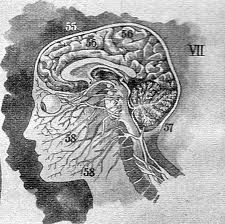.jpg) |
The act of breathing begins at the mouth and nose – the two
entry points for the air surrounding the face; it travels down your throat and
into your trachea where it is divided down the two bronchial tubes. The air is
then divided into smaller passages – the bronchioles, from there it goes into
the alveoli. The alveoli are each surrounded by a mesh of capillaries and the
oxygen diffuses through the alveoli and then capillary wall to bind with
haemoglobin in a red blood cell. This oxygenated blood travels to the heart and
is then pumped to the extremities of the body to allow respiration to take
place. The deoxygenated blood returns to the lungs and the carbon dioxide that
was released during respiration diffuses across the two membranes and is then
exhaled. The diaphragm plays a huge part in respiration, it increases the
pressure in the lungs, forcing exhalation.
 Humans inhale a high concentration of oxygen which enables fast diffusion and is increased due to the low density, whereas water, due
to being a liquid is denser, so therefore would be more difficult to inhale.
Furthermore, exhaling would be nearly impossible due to the weight of water
that would press down on the diaphragm, preventing it from contracting and
therefore it would be impossible to expel the water that has a low
concentration of oxygen to allow the lungs to fill with fresh water.
Additionally, water contains a lower percentage of Oxygen compared to the blood
that has just been freshly oxygenated so realistically the oxygen in the blood
surrounding the alveoli could theoretically diffuse into the water, due to the
concentration gradient being reversed. Moreover, the concentration of oxygen in
air is higher than in water so therefore diffusion will require less energy because
of the high contrast in concentration gradient.
Humans inhale a high concentration of oxygen which enables fast diffusion and is increased due to the low density, whereas water, due
to being a liquid is denser, so therefore would be more difficult to inhale.
Furthermore, exhaling would be nearly impossible due to the weight of water
that would press down on the diaphragm, preventing it from contracting and
therefore it would be impossible to expel the water that has a low
concentration of oxygen to allow the lungs to fill with fresh water.
Additionally, water contains a lower percentage of Oxygen compared to the blood
that has just been freshly oxygenated so realistically the oxygen in the blood
surrounding the alveoli could theoretically diffuse into the water, due to the
concentration gradient being reversed. Moreover, the concentration of oxygen in
air is higher than in water so therefore diffusion will require less energy because
of the high contrast in concentration gradient.
Aquatic respiration is very different to human respiration.
Fish respiration takes place through gills, the water flows to their mouth and
is then forced out of their gills on either side of their body, this means that
the water is filtered through their gills which consist of large amounts of
gill filaments that are all in close proximity of each other. The gill filaments
are all attached to the gill bar, stacked up to be specific and each filament
has lamellae which increase the surface area of the gills. The water flows in
the opposite direction than the blood over the gill filaments; this is known as
countercurrent flow. The principle for aquatic respiration is that the water
flows over the oxygenated blood, allowing oxygen to diffuse into the blood and
then the water flows over the deoxygenated blood, allowing for the oxygen and
carbon dioxide to diffuse out of the blood and into the water. This means that
when the water flows over the oxygenated blood there is a small difference in
the concentration of oxygen in the blood compared to the water, but diffusion
can still take place so the concentration of oxygen dissolved in the water
decreases, so when it proceeds and flows over the deoxygenated blood there is a
concerntration gradient that allows for diffusion out of the blood and into
water.
 The evidence in contrast between human and aquatic
respiration helps to explain why humans cannot respire under water. The different organs and mechanisms used by
each animal for respiration also demonstrates where each creature evolved, and
how they have adapted to allow from respiration in the optimum ppO₂.
The evidence in contrast between human and aquatic
respiration helps to explain why humans cannot respire under water. The different organs and mechanisms used by
each animal for respiration also demonstrates where each creature evolved, and
how they have adapted to allow from respiration in the optimum ppO₂.
I found this image online, but it didn't provide as much answers as I would like, as this picture shows, fish and humans seperated many years ago, even before the renowned Jurassic Period. So, the possibility of humans being able to breathe underwater is so far off possible it is almost bordering on ridiculous. Not only the amount of time since seperation, but the distance, as you can see the different branches show how many species have arisen in between fish and humans.
I have been spreading the word around my school, my viewer numbers have increased considerably, and I am very grateful to the new readers, along with the increasing numbers of those 'across the pond' (Hi american readers!) - I would just like to say thanks to all my readers for reading.
See you all soon, hopefully, School is crazy but I really enjoy writing this.

.jpg)



.jpg)